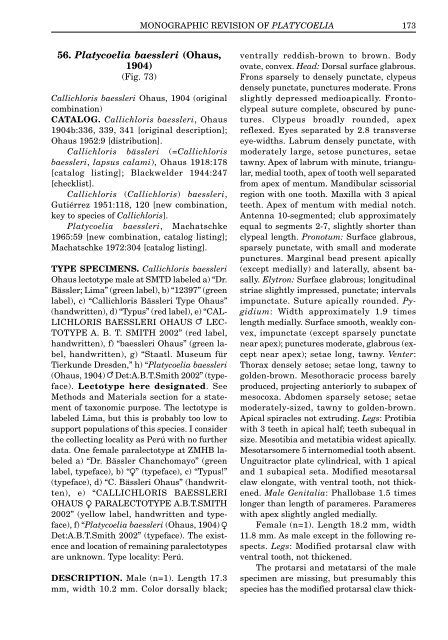Download full text (PDF 4.5 MB) - University of Nebraska State ...
Download full text (PDF 4.5 MB) - University of Nebraska State ...
Download full text (PDF 4.5 MB) - University of Nebraska State ...
You also want an ePaper? Increase the reach of your titles
YUMPU automatically turns print PDFs into web optimized ePapers that Google loves.
MONOGRAPHIC REVISION OF PLATYCOELIA 173<br />
56. Platycoelia baessleri (Ohaus,<br />
1904)<br />
(Fig. 73)<br />
Callichloris baessleri Ohaus, 1904 (original<br />
combination)<br />
CATALOG. Callichloris baessleri, Ohaus<br />
1904b:336, 339, 341 [original description];<br />
Ohaus 1952:9 [distribution].<br />
Callichloris bässleri (=Callichloris<br />
baessleri, lapsus calami), Ohaus 1918:178<br />
[catalog listing]; Blackwelder 1944:247<br />
[checklist].<br />
Callichloris (Callichloris) baessleri,<br />
Gutiérrez 1951:118, 120 [new combination,<br />
key to species <strong>of</strong> Callichloris].<br />
Platycoelia baessleri, Machatschke<br />
1965:59 [new combination, catalog listing];<br />
Machatschke 1972:304 [catalog listing].<br />
TYPE SPECIMENS. Callichloris baessleri<br />
Ohaus lectotype male at SMTD labeled a) “Dr.<br />
Bässler; Lima” (green label), b) “12397” (green<br />
label), c) “Callichloris Bässleri Type Ohaus”<br />
(handwritten), d) “Typus” (red label), e) “CAL-<br />
LICHLORIS BAESSLERI OHAUS M LEC-<br />
TOTYPE A. B. T. SMITH 2002” (red label,<br />
handwritten), f) “baessleri Ohaus” (green label,<br />
handwritten), g) “Staatl. Museum für<br />
Tierkunde Dresden,” h) “Platycoelia baessleri<br />
(Ohaus, 1904) M Det:A.B.T.Smith 2002” (typeface).<br />
Lectotype here designated. See<br />
Methods and Materials section for a statement<br />
<strong>of</strong> taxonomic purpose. The lectotype is<br />
labeled Lima, but this is probably too low to<br />
support populations <strong>of</strong> this species. I consider<br />
the collecting locality as Perú with no further<br />
data. One female paralectotype at ZMHB labeled<br />
a) “Dr. Bässler Chanchomayo” (green<br />
label, typeface), b) “F” (typeface), c) “Typus!”<br />
(typeface), d) “C. Bässleri Ohaus” (handwritten),<br />
e) “CALLICHLORIS BAESSLERI<br />
OHAUS F PARALECTOTYPE A.B.T.SMITH<br />
2002” (yellow label, handwritten and typeface),<br />
f) “Platycoelia baessleri (Ohaus, 1904) F<br />
Det:A.B.T.Smith 2002” (typeface). The existence<br />
and location <strong>of</strong> remaining paralectotypes<br />
are unknown. Type locality: Perú.<br />
DESCRIPTION. Male (n=1). Length 17.3<br />
mm, width 10.2 mm. Color dorsally black;<br />
ventrally reddish-brown to brown. Body<br />
ovate, convex. Head: Dorsal surface glabrous.<br />
Frons sparsely to densely punctate, clypeus<br />
densely punctate, punctures moderate. Frons<br />
slightly depressed medioapically. Frontoclypeal<br />
suture complete, obscured by punctures.<br />
Clypeus broadly rounded, apex<br />
reflexed. Eyes separated by 2.8 transverse<br />
eye-widths. Labrum densely punctate, with<br />
moderately large, setose punctures, setae<br />
tawny. Apex <strong>of</strong> labrum with minute, triangular,<br />
medial tooth, apex <strong>of</strong> tooth well separated<br />
from apex <strong>of</strong> mentum. Mandibular scissorial<br />
region with one tooth. Maxilla with 3 apical<br />
teeth. Apex <strong>of</strong> mentum with medial notch.<br />
Antenna 10-segmented; club approximately<br />
equal to segments 2-7, slightly shorter than<br />
clypeal length. Pronotum: Surface glabrous,<br />
sparsely punctate, with small and moderate<br />
punctures. Marginal bead present apically<br />
(except medially) and laterally, absent basally.<br />
Elytron: Surface glabrous; longitudinal<br />
striae slightly impressed, punctate; intervals<br />
impunctate. Suture apically rounded. Pygidium:<br />
Width approximately 1.9 times<br />
length medially. Surface smooth, weakly convex,<br />
impunctate (except sparsely punctate<br />
near apex); punctures moderate, glabrous (except<br />
near apex); setae long, tawny. Venter:<br />
Thorax densely setose; setae long, tawny to<br />
golden-brown. Mesothoracic process barely<br />
produced, projecting anteriorly to subapex <strong>of</strong><br />
mesocoxa. Abdomen sparsely setose; setae<br />
moderately-sized, tawny to golden-brown.<br />
Apical spiracles not extruding. Legs: Protibia<br />
with 3 teeth in apical half; teeth subequal in<br />
size. Mesotibia and metatibia widest apically.<br />
Mesotarsomere 5 internomedial tooth absent.<br />
Unguitractor plate cylindrical, with 1 apical<br />
and 1 subapical seta. Modified mesotarsal<br />
claw elongate, with ventral tooth, not thickened.<br />
Male Genitalia: Phallobase 1.5 times<br />
longer than length <strong>of</strong> parameres. Parameres<br />
with apex slightly angled medially.<br />
Female (n=1). Length 18.2 mm, width<br />
11.8 mm. As male except in the following respects.<br />
Legs: Modified protarsal claw with<br />
ventral tooth, not thickened.<br />
The protarsi and metatarsi <strong>of</strong> the male<br />
specimen are missing, but presumably this<br />
species has the modified protarsal claw thick-
















